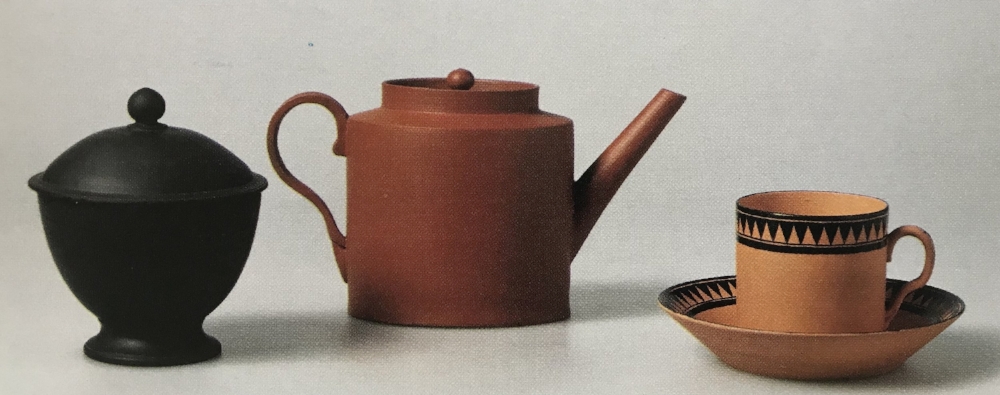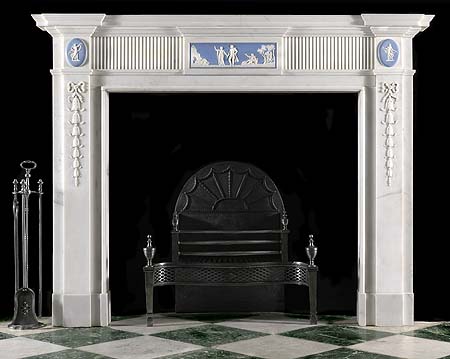Wedgwood.
wedgwood
Five Things You Probably Didn’t Know About Wedgwood
1. Wedgwood was the Ultimate Underdog
Born in Staffordshire, England in 1730, Josiah Wedgwood was the thirteenth child of an impoverished potter. While little is known of his early life, he is known to have walked a seven mile round trip to attend school each day. His father’s death forced him to begin working at the age of just nine as a pottery thrower for his eldest brother. He continued throwing until he was seriously weakened by an attack of smallpox, which led to the amputation of his right leg. However, instead of hindering him, this encouraged Josiah’s love of experimentation and he used his inactivity to read, research and experiment in his craft.
2. Wedgwood was a Willy Wonka of Ceramics
Canopic inkwell, caneware with red Egyptian sprig reliefs. Wedgwood, circa 1798
Wedgwood had a uniquely scientific approach to pottery and an endless capacity for research into materials. When he established his own company in 1759, the ordinary crockery of the day was a cheap stoneware that was dull, porous and broke easily. Within just a few years, he had perfected ‘creamware’, a durable, well finished, cream-colored glazed earthenware which looked like porcelain but was able to withstand temperature changes. It was christened ‘Queen’s Ware’ when Queen Charlotte appointed him Queen’s Potter in 1765 and it soon became the standard domestic pottery, enjoying a worldwide market.
In 1768 he began to manufacture ornamental items, primarily unglazed stoneware in various colors, formed and decorated in the popular Neoclassical style. Most notable amongst these was black basalt (I’ll write more about this later, it’s one of our obsessions and there’s too much to squeeze into this post!) and Wedgwood’s now signature jasperware. Other wares followed, created by adding various coloring oxides. These included rosso antico (red porcelain), cane ware, drab ware, chocolate ware and olive ware - basically Wedgwood explored every shape and function possible.
In addition to his many innovations in stoneware, Wedgwood invented the pyrometer, an invaluable device, a version of which still used today for gauging oven heat for firings. His factory was also the first to install a steam-powered engine.
One of our favorite Wedgwood finds; an early 19th Century Wedgwood Jasperware Medallion of Medusa
Group of Wedgwood Dry Body Teawares. From left: black basalt sugar bowl, 1874; red stoneware teapot 1931, stoneware tea bowl and saucer, 1947
3. Wedgwood was the First to Manipulate the Value of Celebrity
Minimal masterpieces; a selection of Wedgwood Black Basalt Bowls from the 18th - 19th Century
Until Wedgwood, most companies viewed royal commissions as as a hassle with negligible profit. When Empress Catherine II of Russia ordered a 925-piece dinner service in 1773, Wedgwood made about £200 ($280) on an cost of almost £3,000 ($4,200). But Wedgwood knew what he was at. He cleverly exhibited the service in his showroom before it was dispatched so that visitors could view it, with duplicate pieces made available for sale.
Wedgwood courted not only royalty but also painters, architects and other trendsetters of the time, investing huge costs into soliciting strategic sales and endorsements. His strategy relied on fashionable appeal and he made sure his products were hyped in the press. He capitalized on his status as ‘potter to Her Majesty’ to increase prices for the nobility while still extending into the mass market, using efficient manufacturing methods to lower the prices of certain products for a middle class clientele who was unable to purchase goods at the same prices nobility paid. The artistry of his products and his segregation of product price ranges ensured the brand was still highly desired by the wealthy.
4. Wedgwood’s Daughter was Charles Darwin’s Mother
Wedgwood and Erasmus Darwin were both members of the Lunar Society of Birmingham, a nerdy gathering of scientifically-minded men who met once a month at the time of the full moon (so that there would be enough light to ride home in the dark, naturally). In 1780, when Wedgwood's business partner died, he asked Erasmus for help. Erasmus Darwin's son would later marry Wedgwood's daughter, Susannah, and they would become the parents of Charles Darwin. Charles in turn later married a Wedgwood and in fact, widespread inbreeding between the Darwin and Wedgwood families was probably to blame for Charles Darwin's ill health, and the childhood tragedies and infertility that plagued his family.
Solid blue jasper Portland Vase of which a number were made in 1971. This particular vase was presented to the British Museum by Josiah II in 1802.
5. Wedgwood is the Father of Modern Marketing
For Wedgwood, selling was an intellectual pleasure, an art form. Most, if not all, common 20th-century sales techniques - direct mail, money-back guarantees, traveling salesmen, self-service, free delivery, buy one get one free - came from Wedgwood. He was amongst the first manufacturers to create customer loyalty and a ‘brand image’, and he went to great lengths to make sure consumers were aware of - and desired - his products.
Wedgwood was perceptive and quick to adapt to consumer demand and trends. For example, as tea consumption in Britain rose, Wedgwood adapted his product line to include more cups, pitchers, pots and sugar bowls. By the time of his death, 36 years after he opened his first workshop, his wares were being sold worldwide and he had accumulated a fortune worth about £500 million ($698,000,000) in today’s terms. Though he worked three centuries ago, Forbes.com have included Josiah Wedgwood in their list of the most influential businessman of all time.
English Wedgwood marble fireplace












